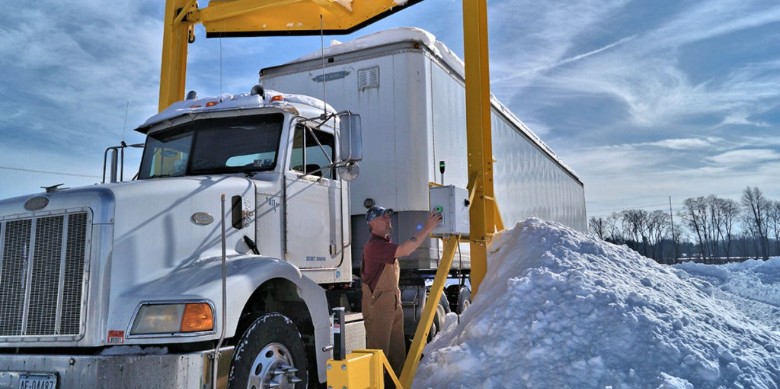
Snow and ice accumulation on trailers, trucks and buses is more than a seasonal inconvenience. That buildup also becomes a serious safety risk and a drag on operations and budgets.
Skipping the rooftop snow removal process isn’t an option. But solutions for manually removing snow come with their own safety risks and costs.
If your team isn’t removing snow or is still relying on ladders, rakes, brooms and improvised tools to remove rooftop snow, it’s time to consider the financial downsides — or another option that can give you economic savings.
The cost of doing nothing
Skipping snow removal entirely is risky and can be both financially catastrophic – and depending on where you’re located, against the law as well.
- Legal responsibility. Snow and ice falling or launching from moving vehicles can cause accidents. According to the American Transportation Research Institute, the median settlement for just one of those lawsuits can be $100,000+.
- Nuclear verdicts. Some accident cases are disproportionate to actual financial damages. These punitive verdicts have exceeded $10 million in trucking incidents (according to the American Transportation Research Institute).
- Regulatory fines. Several U.S. states and Canadian provinces have laws in place that require snow removal, with fines up to $1,500 in some states. Beyond that, all states and provinces have regulations for maximum weight and secured loads.
- Wasted fuel. A few inches of rooftop snow accumulation adds hundreds of pounds to loads, affecting fuel economy by 2% or more with its weight and drag. Jack Gray’s Roof Observations calculated that heavy, wet snow can weigh 21 lbs. per cubic ft. Six inches on a 53′ trailer (450 sq ft) can add 4,730 pounds. According to North American Council for Freight Efficiency (NACFE), reduction of 1,000 lbs. results in 0.5-0.6% improvement in fuel economy for a typical Class 8 truck.
- Insurance increases. Snow-related incidents can cause premiums to spike across an entire fleet.
- Unnecessary wear and tear Snow and ice left on trucks and trailer rooftops is heavy and can cause roof collapse and other unnecessary equipment damage.
- Reputation hits. Accidents caused by your fleet can permanently damage customer trust, recruitment efforts and public sentiment.
The hidden costs of manual snow removal
Manual clearing might get the job done, but it’s neither simple nor inexpensive. It doesn’t give you the fast turnaround trucking companies need to get vehicles on the road quickly and safely.
- Labor drain. Clearing each vehicle can take 20–30 minutes depending on how many workers are on the task. Multiply that by dozens (or hundreds) of vehicles per storm and you’re either paying your potentially aging workforce a lot for low-value work time or spending on contracted jobs.
- Idle time. Every minute a vehicle sits waiting for snow removal is a potential missed delivery, delayed route or lost productivity. Customers and suppliers take notice. And the ripple effect hurts scheduling, efficiency and reputation.
- Injury risk. Slippery rooftops and makeshift tools lead to costly injuries. One accident can cost companies $60,000–$100,000 or more, not including downtime, workers compensation claims and being shorthanded as they recover.
- Equipment damage. Long-handled snow rakes, makeshift tools and boots on rooftops cause damage to surfaces and structural elements, creating long-term repair costs that rarely get tracked.
Automated equipment turns risk into ROI
There is a third option. Automated snow-removal systems transform a recurring winter problem into opportunities for safety and efficiency.
Below are some ways to experience the cost savings of automated snow removal systems for trucks and buses.
Key ROI drivers:
- On-time performance. Automated snow removal of up to 24 inches in under 30 seconds gets vehicles back on the road faster to mitigate late fees and contract penalties.
- Fuel savings. Quick clearing of snow or ice reduces drag and weight while improving fuel economy.
- Talent recruitment and turnover. Employees want to work for the safest, most efficient operations. Adding a fleet plow can be a selling point to attract and retain workers.
- Injury reduction. For snow removal, fleet plows remove workers from hazardous conditions on the ground and, in some cases, from the tops of trucks and trailers, cutting OSHA-reportable injuries and claims.
- Durability. Scraper Systems machines are built for harsh winters, backed by warranty and designed with simplicity for long-term use.
- Public safety. Beyond expensive lawsuits and reputational damage, there’s no way to calculate the cost of pain and suffering from rooftop snow- and ice-related accidents.
In many cases, avoiding just one injury can fully offset the price of a Scraper Systems unit.
Results from real-world fleets
- Boscov’s Department Stores: Eliminated manual snow removal for 650 trailers across two sites.
- Foxborough Public Schools: Cleared 27 buses in 1.5 labor hours vs. 20 labor hours previously.
- Sunrise Transport: Reduced idle time and labor costs for a 130-vehicle fleet.
Don’t let snow pile up on your bottom line
Manual snow removal drains your budget, slows your fleet and increases risk. Doing nothing is easier and less expensive — we see above that this decision comes with huge risks, though. A Scraper Systems fleet plow pays for itself through measurable financial savings and improved safety.
For leaders in safety, operations and fleet management who focus on uptime and cost control, powered rooftop snow removal turns winter from a liability into a win.
Ready for winter? Don’t wait for an injury, accident or unexpected expenses to force change. Find out what you might save with our custom ROI calculator. To ask questions or request a quote, contact Scraper Systems by Rite-Hite.